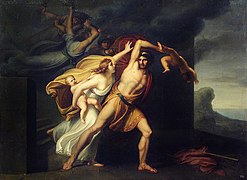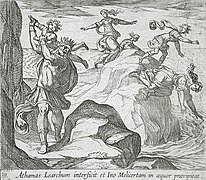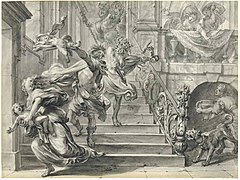Ino (Greek mythology)
| Ino | |
|---|---|
Queen of Polydorus | |
| Consort | Athamas |
| Offspring | Learchus and Melicertes |
In
Family
Ino was the second daughter of the King
Ino was a primordial Dionysian woman, nurse to the god and a divine maenad. (Kerenyi 1976:246)
Ino was the second wife of the Minyan king Athamas, mother of Learchus and Melicertes and stepmother of Phrixus and Helle
Mythology
Later, Ino raised

The story of Ino,
After Ino's disappearance, some of her companions began to revile Hera, so the goddess turned them into birds according to Ovid,[6] perhaps aithuia birds (shearwaters?).[7]
When Athamas returned to his second wife, Ino, Themisto (his third wife) sought revenge by dressing her children in white clothing and Ino's in black and directing the murder of the children in black. Ino switched their clothes without Themisto knowing and she killed her own children.
Transformed into the goddess Leucothea, Ino also represents one of the many sources of divine aid to
In historical times, a sisterhood of maenads of Thebes in the service of Dionysus traced their descent in the female line from Ino; we know this because an inscription at Magnesia on the Maeander summoned three maenads from Thebes, from the house of Ino, to direct the new mysteries of Dionysus at Magnesia (Burkert 1992:44).
Festivals
Inoa (Ἰνῶα), there were festivals which were celebrated in many different places in honour of Ino.[8]
Genealogy
|
Gallery
-
Atamante preso dalle Furie by Arcangelo Migliarini (1801) at Roma, Accademia di San Luca
-
Athamas und Ino by Radierung (17th century)
-
The Insane Athamas Killing Learchus, While Ino and Melicertor Jump into the Sea by Wilhelm Janson (Holland, Amsterdam), Antonio Tempesta (Italy, Florence, 1555–1630) at Los Angeles County Museum of Art, Los Angeles
-
Tisiphone maddens Athamas & Ino (17th century)
-
Athamas tearing apart his children by Godfried Maes
Notes
- ^ Henry George Liddell. Robert Scott. A Greek-English Lexicon
- ^ Alcman, fr. 50b Campbell, pp. 428, 429.
- ^ Hesiod, who calls her only Ino, lists her among the "glorious offspring" of unions between a mortal and a goddess (Theogony 975 ff.)
- ^ Bibliotheke 1.9.1; "it is possible, however", Kerenyi suggests (The Gods of the Greeks p 264) "that originally she did not cause the seed-corn to be roasted, but introduced the practice of roasting corn in general."
- Brasiai in Laconia. (Kerenyi 1951:264).
- ISBN 978-0-19-955692-2.
- ISBN 0-521-58230-X.
- ^ A Dictionary of Greek and Roman Antiquities (1890), Inoa
References
- Apollodorus, The Library with an English Translation by Sir James George Frazer, F.B.A., F.R.S. in 2 Volumes, Cambridge, MA, Harvard University Press; London, William Heinemann Ltd. 1921. ISBN 0-674-99135-4. Online version at the Perseus Digital Library. Greek text available from the same website.
- Burkert, Walter, 1992. The Orientalizing Revolution: Near Eastern Influence on Greek Culture in the Early Archaic Age (Cambridge:Harvard University Press).
- Campbell, David A., Greek Lyric, Volume II: Anacreon, Anacreontea, Choral Lyric from Olympus to Alcman, .
- Dalby, Andrew (2005), The Story of Bacchus, London:British Museum Press, ISBN 0-89236-742-3) pp. 36–42, 151
- Hesiod, Theogony from The Homeric Hymns and Homerica with an English Translation by Hugh G. Evelyn-White, Cambridge, MA.,Harvard University Press; London, William Heinemann Ltd. 1914. Online version at the Perseus Digital Library. Greek text available from the same website.
- Kerenyi, Karl, 1976. Dionysus: Archetypal Image of Indestructible Life (Princeton: Bollingen).
- Kerenyi, Karl, 1951. The Gods of the Greeks (Thames and Hudson).
External links
 Media related to Ino at Wikimedia Commons
Media related to Ino at Wikimedia Commons








